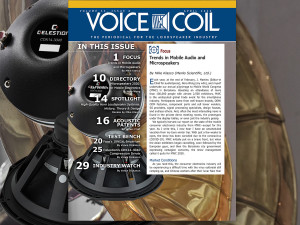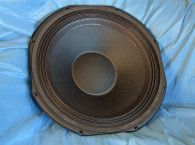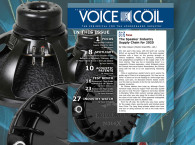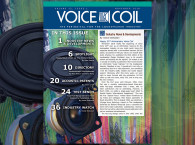 As scheduled, Voice Coil April 2020 is now available in print and digital, connecting loudspeaker professionals in these challenging times.
As scheduled, Voice Coil April 2020 is now available in print and digital, connecting loudspeaker professionals in these challenging times.
The Voice Coil Focus for this edition is "Trends in Mobile Audio and Microspeakers," an insightful article by Mike Klasco (Menlo Scientific, Ltd.). As the mobile industry was not able to gather as usual for another edition of Mobile World Congress (MWC) in Barcelona, and as the consumer electronics industry is just barely starting to recover as China resumes production, this is an important overview of what smartphone makers and all the related personal audio and smart home industries will be focusing on for their new-generation products, predictably available before the end of the year, and throughout 2021. The main topic for everyone in the industry, how to improve sound quality and efficiency with the extreme size restrictions and, most important, power limitations.
And considering that microspeakers in smartphones have always been the key component for audio playback in gaming, music, and voice mobile applications, where AAC, Goertek, and many other giants are major manufacturers with programs for refining microspeaker performance, Nora Wong (Menlo Scientific, Ltd.) has compiled an updated directory on "Key Vendors for Mobile Electronics and Microspeakers."
Also included in this edition, for those readers who have not read about it yet, Mike Klasco reviews High-Quality Horn Loudspeaker Systems: History, Theory & Design, the massive reference book written by Bjørn Kolbrek and Thomas Dunker. Klasco confirms he will need to study the essential work for months if not years.
In Acoustic Patents, our expert James Croft (Croft Acoustical), reviews a Complementary Driver Alignment patent recently awarded to Harman International Industries, Inc. (Stamford, CT), and listing Chris N. Hagen (Simi Valley, CA) as the sole inventor. In the abstract, the patent describes the focus to be examples for tuning loudspeakers, including an amplifier configured to generate an audio signal, and a plurality of speakers connected in parallel to the amplifier, wherein each speaker has a unique impedance characteristic that, when combined with the impedance characteristics of the other speakers, shows all speaker impedance characteristics to be complementary, resulting in a more level, or resistive, overall speaker system load impedance. This more level, or resistive, overall speaker system load impedance results in a more dynamic sound with more extended low end in comparison to conventional speaker systems. An interesting concept that advances former approaches.
In this month's Test Bench, Vance Dickason opens the benchwork with the latest 18NDXL Imperium, a very high power handling 18" low-frequency woofer from British brand Fane. Designed by this revitalized company with a rich history (described on Fane International’s website at www.fane-international.com), the 18NDXL Imperium includes uses as a bass driver in multiway systems or as a dedicated woofer in bass reflex or horn loaded designs. The feature set for the 18NDXL is like most high-performance pro sound drivers, rather substantial. Starting with the frame, the 18NDXL uses a proprietary eight-spoke cast-aluminum frame incorporating eight 40 mm x 10 mm rectangular vent holes in the area below the spider mounting shelf for enhanced voice coil cooling. This series of cooling vents allows air to move past the voice coil and across the front side of the neodymium motor assembly.
The cone assembly consists of a curvilinear paper cone along with a 6” diameter convex paper dust cap. Compliance is supplied by pleated coated cloth M-type surround and from two 6” diameter flat cloth spiders (dampers) mounted back-to-back on a 20 mm height aluminum standoff at the base of the frame. The Fane 18NDXL Imperium’s motor is based on a neodymium ring magnet structure. The neodymium magnet motor was FEA designed using a 127 mm (5”) diameter voice coil wound with round copper wire on a non-conducting glass fiber former. Motor parts, such as the return cup and rear heatsink plate are coated with a black heat-emissive coating for improved cooling, with the cooling additionally enhanced by a 63 mm flared pole vent. In addition to the convection cooling enhancements, the 18NDXL also an aluminum core heatsink, which further wicks heat from the voice coil assembly. Factory-rated power handling for this driver is 1200 W AES and 2400 W program.
Next up in Test Bench is the characterization of Celestion’s CDX14-3040 Compression Driver, another British flagship brand, founded in 1924. The transducer Celestion sent for Test Bench joins the extensive CDX line of neodymium motor compression drivers, now totaling 12 models (the Celestion ferrite line of compression drivers has grown to 17 models). Designed for use with 1.4” throat horns, the CDX14-3040 (which is an updated neodymium version of the CDX14-3030 ferrite compression driver) has a 35.6 mm (1.4”) throat diameter driven by a 75 mm (3”) diameter voice coil wound with edge-wound copper clad aluminum wire (CCAW) on a non-conducting former driving a single-piece titanium diaphragm and surround. The diaphragm is fixed using Celestion’s Sound Castle soft clamping assembly methodology, which purports to reduce the stress associated with holding the diaphragm in place, decreasing distortion and increasing reliability. The CDX14-3040 also incorporates a three-slot annular phase plug and an acoustically damped diecast aluminum cover. Other features include an FEA-optimized neodymium magnet motor structure, a continuous power handling of 150 W with a 75 WRMS power handling rating, a 1 kHz recommended crossover frequency (with a minimum 12 dB/octave high-pass network), and 1 W/1 m 106.5 dB sensitivity (measured 2 π on a typical horn). Along with the CDX14-3040, Celestion supplied its new 1.4” H14-7050 70° x 50° constant directivity horn in a 3D printed version that should be in production by the time this test gets published.
 Finally, in Industry Watch, Vance Dickason discusses the latest Consumer Technology Association report regarding industry trends, and the current status of postponed and cancelled shows.
Finally, in Industry Watch, Vance Dickason discusses the latest Consumer Technology Association report regarding industry trends, and the current status of postponed and cancelled shows.
The April 2020 edition of Voice Coil is available for download and already in the mail for print subscribers. Subscribers can go to - www.gotomyvcoil.com - to download this issue.
Remember, Voice Coil is available in print and download for all registered subscribers, free for industry professionals. To qualify for a free subscription to Voice Coil, or renew your subscription, go to: audioxpress.com/page/Voice-Coil-Subscriber-Services.html
See also this note regarding Access to Digital Subscriptions - Click here

- on Magazine News
- News
Voice Coil April 2020 Now Available and Keeping the Loudspeaker Industry Together
March 27 2020, 16:10
As scheduled, Voice Coil April 2020 is now available in print and digital, connecting loudspeaker professionals in these challenging times. This month, Mike Klasco (Menlo Scientific) discusses Mobile Audio and Microspeakers, which is also the topic of this month's updated directory. James Croft reviews a patent from Harman, while Vance Dickason characterizes the new 18NDLX Imperium woofer from Fane and the CDX14-3040 compression driver from Celestion. Download now and start reading!





